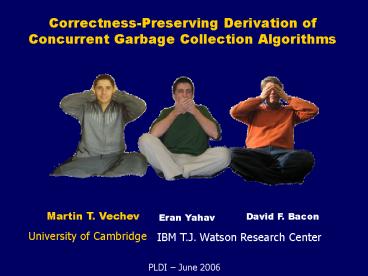Correctness-Preserving Derivation of Concurrent Garbage Collection Algorithms - PowerPoint PPT Presentation
1 / 24
Title:
Correctness-Preserving Derivation of Concurrent Garbage Collection Algorithms
Description:
Correctness-Preserving Derivation of Concurrent Garbage Collection Algorithms. Martin T. Vechev ... Correctness-preserving 'transformations' A Parametric ... – PowerPoint PPT presentation
Number of Views:39
Avg rating:3.0/5.0
Title: Correctness-Preserving Derivation of Concurrent Garbage Collection Algorithms
1
Correctness-Preserving Derivation of Concurrent
Garbage Collection Algorithms
Martin T. Vechev
David F. Bacon
Eran Yahav
University of Cambridge
IBM T.J. Watson Research Center
PLDI June 2006
2
Why Concurrent Garbage Collection ?
- Java and C
- Garbage-collected languages are prevalent
- Multicore
- Concurrency is becoming prevalent
- Cheap RAM
- Large heaps are becoming prevalent
- Real-Time Systems
- More widely used
3
Existing Way to Create a Concurrent GC
REQUIREMENTS
ENVIRONMENT
Throughput Memory Consumption Pause Time
Memory Model Thread Model Concurrency
Primitives CPU primitives
TECHNIQUES
Tracing/reference counting moving Allocate White
/ Black Dijkstra / Steele / Yuasa Barrier Atomic
/ Incremental Stack Snapshot Write Barrier Atomic
/ Non-atomic Color toggle, stacklets etc etc etc
??
- Hard to verify/test
- Often buggy
- Did the monkey
- choose well??
Implementation
4
Concurrent GC algorithms and proofs are hard
Yuasa 90
Steele(C) 75
Dijkstra(C) 78
FAMILY
Ben-Ari Base 84
Doligez(C) 93
Boehm 91
Azatchi 03
Ben-Ari Extended 84
Barabash 03
ALGORITHMS
Domani 03
Ben-Ari Base 84
Doligez 94
Pixley 88
PROOFS
THEOREM PROVING
5
Our Research Vision
ENVIRONMENT (Declarative Specification)
REQUIREMENTS
Memory Model Thread Model Concurrency
Primitives CPU primitives
Throughput Memory Consumption Pause Time
Automated System
Formally Defined Techniques
Optimal Correct Implementation
6
In This Work
FIXED ENVIRONMENT
REQUIREMENTS
Memory Model Thread Model Concurrency
Primitives CPU primitives
Throughput Pause Time
Memory Consumption
Automated System
Formally Defined Techniques for Tracing Non-
Moving GC
Algorithm 1
Algorithm 2
Algorithm 3
Algorithm N
lt
lt
lt
7
Problem Interference
SYSTEM MUTATOR GC
B
C
A
1. GC traced B
8
Problem Interference
SYSTEM MUTATOR GC
B
B
C
C
A
A
1. GC traced B
2. Mutator links C to B
9
Problem Interference
SYSTEM MUTATOR GC
B
B
B
C
C
C
X
A
A
A
1. GC traced B
2. Mutator links C to B
3. Mutator unlinks C from A
10
Problem Interference
SYSTEM MUTATOR GC
C LOST
B
B
B
B
C
C
C
C
A
A
A
A
1. GC traced B
2. Mutator links C to B
3. Mutator unlinks C from A
4. GC traced A
11
The 3 Families of Concurrent GC Algorithms
3. Rescan B when C is linked to B (STEELE)
1. Marks C when C is linked to B
(DIJKSTRA)
2. Marks C when link to C is removed
(YUASA)
B
B
B
B
C
C
C
C
C
X
A
A
A
- Solutions are applied uniformly for all objects
12
Contributions
- Systematic Exploration
- A new parametric model of concurrent GC
- Better understanding
- New algorithms potentially useful
- Formal Relationship between algorithms
- Space - Relative precision between algorithms
- Sharing Proof Burden
- Correctness-preserving transformations
13
A Parametric Concurrent GC Skeleton
- Intuition Common out as much as possible
- Record interaction history between collector and
mutator during tracing - Collector exposes hidden objects based on
entire interaction history
14
A Parametric Concurrent GC Skeleton
Complete Garbage Collection
COLLECTOR
mark
reclaim
Expose(L,D)
mark
Expose(L,D)
MUTATOR
Change Heap
Change Heap
15
Dimensions an intuition
- The effect of each Mutator/GC action is
controlled by a dimension
A
B
X
Collector Scans Pointer Wavefront Granularity
Mutator Creates Pointer Counting
Mutator Overwrites Pointer Snapshot
Mutator Allocates Object Allocation Color
16
Implementation Choice Wavefront
- Per-Field Wavefront
- Exact information
- One bit per field
- More expensive
- More synchronization
- More garbage collected
- Per-Object Wavefront
- Approximate Information
- One bit per object
- Less expensive
- Less synchronization
- Less garbage collected
17
Choice Record on Link or Unlink
X
- Record on Link
- More synchronization
- More garbage collected
- Record on Unlink
- Less synchronization
- Less garbage collected
18
Combined Choices
A
B
A
B
X
Per-Object WF
A
B
A
B
X
Per-Field WF
Record on Link
Record on Unlink
19
Combined Choices Per Object
A
B
Per-Obj A Per-Obj B
X
X
Per-Obj A Per-Field B
X
X
X
X
Per-Field A Per-Obj B
Per-Field A Per-Field B
X
X
Rec. Link A Rec. Link B
Rec. Link A Unlink B
Rec. Unlink A Rec. Link B
Rec. Unlink A Rec. Unlink B
20
Correctness
- Transformations Proof Steps
APEX (U, U, U, U, )
START WITH A CORRECT ALGORITHM
RETAIN LESS GARBAGE
STEELE
DIJKSTRA (stacks,U,,U,)
STEELE-YC
STEELE-D
STEELE-D-YC
DIJKSTRA-OLD
DIJKSTRA-YC
STEELE-BC
DIJKSTRA-BC
HYBRID-YC (stacks,A,,,)
STEELE-D-BC
RETAIN MORE GARBAGE
YUASA (stacks, A, , , U)
21
Relative Precision
- Intuition an algorithm is more precise than
another if it collects more garbage - An algorithm that is less precise (more
conservative) than a correct algorithm is
guaranteed to be correct - Should be a reference point for practical
comparisons - no ad-hoc methods
- Hard to do manually need a tool to provide
insights - Finding the right definition was harder than
proving safety, yet simpler than relative
concurrency
22
Precision
APEX (U, U, U, U, )
MORE PRECISE
STEELE
DIJKSTRA (stacks,U,,U,)
STEELE-YC
STEELE-D
STEELE-D-YC
DIJKSTRA-OLD
DIJKSTRA-YC
STEELE-BC
DIJKSTRA-BC
HYBRID-YC (stacks,A,,,)
STEELE-D-BC
LESS PRECISE
YUASA (stacks, A, , , U)
23
Conclusions
- Systematic exploration of an algorithm space
- Useful new algorithms
- Formal definition of Relative precision between
algorithms - A first step towards automatic derivation of
concurrent garbage collectors
24
The End































